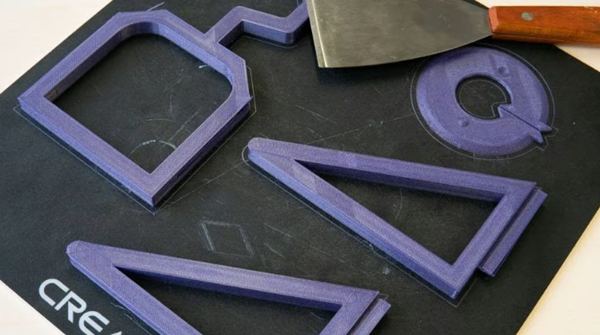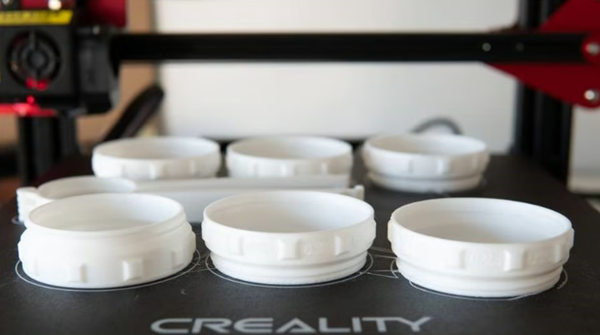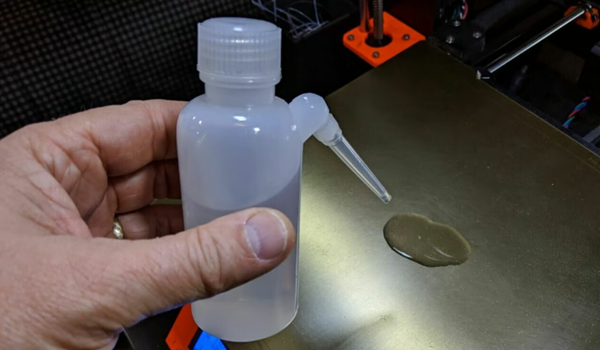Remove build plate prints,Can be a difficult and dangerous process,especiallyThe first coat has too much adhesionhour.In this article,magic monkey networkWillLearn with everyoneRemove from build plateSeveral different ways to 3D print parts.
A,Apply brute force
a fewimpressionCan be unplugged directly from the bed (Source:All 3DP)
The first method is obvious: use brute force. For this you only need your hands. Use one hand to hold the model in place and the other to push or pull the print away from the surface. This can be a dangerous process, as suddenly detaching it from the surface of the bed can cause your hand to hit something, so be careful when removing parts this way.
You can also try using a sturdy object to remove the part from the print bed. This method works well if there is a gap between the build plate and the object in the print area.
Keep in mind that brute force methods should only be used if the print is solid. More detailed prints with many small features are more likely to be damaged in the process, especially if they don’t have a smooth, easy-to-grip surface.
two,Use a flat blade

A sharp blade may be necessary, but care should be taken when using it (source:All 3DP)
The second (and probably most common) method of disassembling parts is to use a flat, sharp blade, such as a scraper. These tools come in all shapes and sizes. You can even use a paint scraper or a large flathead screwdriver.
No matter what blade you use, the most important thing is to be safe. It’s not difficult to accidentally cut yourself or knock parts out of bed. To avoid injury, always keep the blade away from you. When doing this, be careful not to scratch the print surface, as this will make the print bed difficult to level and may affect the adhesion of future prints.
three,generate a temperature difference
You can place the build plate in the refrigerator or freezer to cool(source:Jamaica Hospital Medical Center)
Another way to remove the print from the bed is to let it cool. As materials cool, they shrink and you can take advantage of the different cooling rates of the build surface and the printed part. This method works best if your build plate is made of a temperature-sensitive material like glass or aluminum.
To do this, first let the build plate and print cool to room temperature. Then, if the part is still stuck, place the build board (with the stuck part) in a cool place. This could be a refrigerator, freezer, or a vent that blows out cold air. If the template is too large or cannot be deleted, there is an alternative.
Let it sit for a few minutes or until the base temperature is moderate, then try to remove the print. The print should come off easily. If that doesn’t work, try putting the model back in a cold environment for a longer period of time or use one of the other methods on this list.
However, if you are using a glass substrate, thermal shock can cause problems, so make sure the build plate is at room temperature before placing it in the refrigerator or freezer.
Four,dental floss
3D printing could use the same action as flossing to clean teeth (Source: lookwhatjoeysmaking via Instructables)
Although this method is a bit unconventional, flossing is very effective in removing stuck areas on your bed. You want to move it back and forth like a saw. This back-and-forth movement creates friction that makes parts easier to remove.
Although dental floss is probably the most widely used tool for this unconventional method, you can also use stronger, rope-like products, like jewelry wire or even heavy gauge soldering wire.
Once you have the wire or yarn, wrap it around the bottom of the print so that it rests on the build plate, then pull it toward you in a quick back-and-forth motion. Eventually, your pieces should give way and come off the build board, probably with a new smell!
five,Rinse with cold water
Running the build plate underwater creates a sufficient temperature difference (source:Luke Stafford via YouTube)
This method is as simple as placing the pieces in a constant stream of cool or cool water. The process is similar to placing a print in a refrigerator: you intentionally create a temperature difference between the materials.
You need to wait for everything to cool down to room temperature. If the pieces are still stuck, remove the build plate and place it in the sink. If you used glue, lacquer, or a similar adhesive, first rinse the bottom of the print with warm (but not too hot) water to remove some of the adhesive.
Next, run moderately cool or cold water over the build plate for a few minutes. If possible, try to avoid getting the print wet, as this method works best if only the build surface or print is cooled. Another benefit is that the water flow continues to remove any remaining adhesive.
After a few minutes, you can try again to remove the part using your hands or an indiscreet tool such as a scraper. If your print still doesn’t move, soak the build plate in cold water for a longer period of time or try another method.
six,Add solvent
You should minimize the amount of solvent you use (source:bobstro via the Prusa search forum)
The final way to remove parts from a build plate is to use solvents. Remember not to try solvents first as they can damage the print surface. If you usePEI sheets, painter’s tape or similar surfaces, not to mention solvents, cannot be used.
If you have exhausted all other methods and want to use solvents to remove the parts, there are several good options; the two most commonly used are isopropyl alcohol (IPA) and acetone. Applying solvent to the area where the print base meets the print bed will soften the affected area, making it easier for pry tools to remove the print from under the print bed.
When using solvent, apply a little to the connection point between the print bed and the print. Make sure you don’t use too much, otherwise it could lead to other problems such as degradation of the build surface.
Daguang focuses on providing solutions such as precision CNC machining services (3-axis, 4-axis, 5-axis machining), CNC milling, 3D printing and rapid prototyping services.















































